AT
-
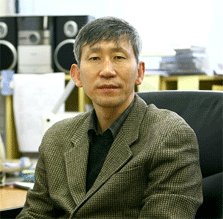 Professor Suk-Bok Chang receives 14th Korea Science Award in the field of Chemistry
Professor Suk-Bok Chang from the Department of Chemistry at KAIST received the “2013 Korea Science Award” in chemistry hosted by the National Research Foundation and the Ministry of Science, ICT, and Future Planning, Republic of Korea.
The Korea Science Award is a presidential award of Korea, which was first established in 1987 to recognize research excellence in natural science. Three scientists are selected for the award in every other year.
Professor Chang primarily researches the catalyzing mechanism of carbon-hydrogen bonds in organic molecules. He has succeeded in making great progress in the field of organic chemistry especially in developing a new type of transition metal catalytic behavior that can be applied to low-reactivity compounds.
Hydrocarbons are abundant in nature, but its unreactive nature in ambient conditions makes it unsuitable as reactant for compound synthesis. In addition, the mechanism behind transition metal catalyzed carbon-hydrogen bond synthesis has not been proven sufficiently.
The prediction that fossil fuels will be depleted before the end of the century makes hydrocarbon synthesis an extremely important matter.
The need for an effective hydrocarbon synthesis method inspired Professor Chang to pursue research in the transition metal catalysis method and to develop a catalytic system that would allow efficient synthesis even in ambient conditions.
Professor Chang has been the lead researcher for the Institute for Basic Science’s “molecule catalysis reaction research team” since December 2012 and has been carrying out this research in KAIST.
2014.01.27 View 10743
Professor Suk-Bok Chang receives 14th Korea Science Award in the field of Chemistry
Professor Suk-Bok Chang from the Department of Chemistry at KAIST received the “2013 Korea Science Award” in chemistry hosted by the National Research Foundation and the Ministry of Science, ICT, and Future Planning, Republic of Korea.
The Korea Science Award is a presidential award of Korea, which was first established in 1987 to recognize research excellence in natural science. Three scientists are selected for the award in every other year.
Professor Chang primarily researches the catalyzing mechanism of carbon-hydrogen bonds in organic molecules. He has succeeded in making great progress in the field of organic chemistry especially in developing a new type of transition metal catalytic behavior that can be applied to low-reactivity compounds.
Hydrocarbons are abundant in nature, but its unreactive nature in ambient conditions makes it unsuitable as reactant for compound synthesis. In addition, the mechanism behind transition metal catalyzed carbon-hydrogen bond synthesis has not been proven sufficiently.
The prediction that fossil fuels will be depleted before the end of the century makes hydrocarbon synthesis an extremely important matter.
The need for an effective hydrocarbon synthesis method inspired Professor Chang to pursue research in the transition metal catalysis method and to develop a catalytic system that would allow efficient synthesis even in ambient conditions.
Professor Chang has been the lead researcher for the Institute for Basic Science’s “molecule catalysis reaction research team” since December 2012 and has been carrying out this research in KAIST.
2014.01.27 View 10743 -
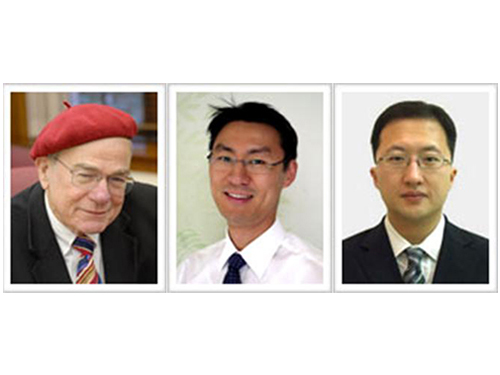 Materials Developed for Sodium Rechargeable Battery by EEWS
The research group of Professor William Goddard III, You-Sung Jung, and Jang-Wook Choi from the Graduate School of Energy, Environment, Water, and Sustainability (EEWS) at KAIST has developed a new sodium-ion rechargeable battery which operates at a high voltage, can be charged, and stably discharges over 10,000 cycles. The research results were published in the online version of the Proceedings of the National Academy of Sciences of the United States of America (PNAS) on December 30, 2013.
Since the material costs of sodium rechargeable batteries is 30 to 40 times lower than lithium batteries, it has received attention as an energy saving tool for smart grids and as the next generation of lithium rechargeable batteries. Until now, sodium-ion rechargeable batteries have had issues with stability when charging and discharging. The research group developed a vanadium-based electrode to solve these problems.
The group said follow-up research will be continued to develop advanced technology on sodium rechargeable batteries as it is still currently in the beginning stages.
The research team: From left to right is Professors William Goddard, You-Sung Jung, and Jang-Wook Choi
2014.01.13 View 11005
Materials Developed for Sodium Rechargeable Battery by EEWS
The research group of Professor William Goddard III, You-Sung Jung, and Jang-Wook Choi from the Graduate School of Energy, Environment, Water, and Sustainability (EEWS) at KAIST has developed a new sodium-ion rechargeable battery which operates at a high voltage, can be charged, and stably discharges over 10,000 cycles. The research results were published in the online version of the Proceedings of the National Academy of Sciences of the United States of America (PNAS) on December 30, 2013.
Since the material costs of sodium rechargeable batteries is 30 to 40 times lower than lithium batteries, it has received attention as an energy saving tool for smart grids and as the next generation of lithium rechargeable batteries. Until now, sodium-ion rechargeable batteries have had issues with stability when charging and discharging. The research group developed a vanadium-based electrode to solve these problems.
The group said follow-up research will be continued to develop advanced technology on sodium rechargeable batteries as it is still currently in the beginning stages.
The research team: From left to right is Professors William Goddard, You-Sung Jung, and Jang-Wook Choi
2014.01.13 View 11005 -
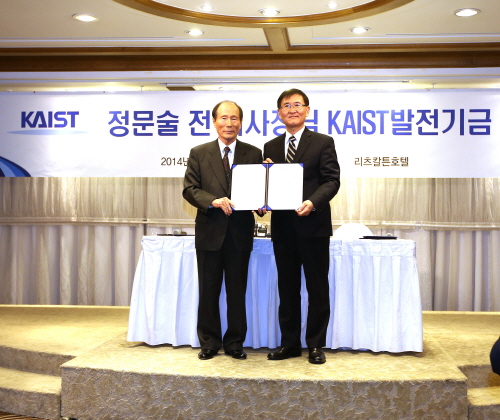 KAIST receives $20 million donation for futures studies
A retired businessman, Moon-Soul Chung, the former chief executive officer of Mirae, Inc., a semiconductor equipment company in Korea, today donated USD 20 million to the Graduate School of Future Strategy at KAIST.
It was Chung's second contribution to KAIST—his first donation of USD 28 million in 2001 supported the construction of the Bio and Brain Engineering building, a major research center on campus where biotechnology and information technology converge.
Established in 2013, the KAIST Graduate School of Future Strategy consists of three interdisciplinary graduate programs on future strategy, intellectual property, and science journalism. The Research Center for Future Strategy is an affiliate of the graduate school. KAIST is the first Korean university that offers an academic program granting a degree in futures studies.
The rapid advancement in science and technology today affects, profoundly and extensively, all corners of global society from education, politics, economy, and environment to resources, sustainability, and inequality. As we live in a highly interconnected, digitalized, and unpredictable world, analyzing the events, trends, patterns, and changes of the past and present, developing foresight, and mapping preferred futures have become more relevant than ever.
KAIST utilizes its strong tech-knowledge base in science and engineering to offer students a high quality education and training in futures thinking, skills, and methodologies to develop foresight and to plan future strategies for international relations, business and industry, national defense, science and technology, and new media. KAIST also anticipates helping government, business, public service, and non-profit organizations identify important issues and develop long-range implementation strategies to prepare for probable and preferred futures.
Moon-Soul Chung (left), the former CEO of Mirae Inc., and President Steve Kang (right), holding together the donation agreement in Seoul, January 10th, 2014
2014.01.13 View 8523
KAIST receives $20 million donation for futures studies
A retired businessman, Moon-Soul Chung, the former chief executive officer of Mirae, Inc., a semiconductor equipment company in Korea, today donated USD 20 million to the Graduate School of Future Strategy at KAIST.
It was Chung's second contribution to KAIST—his first donation of USD 28 million in 2001 supported the construction of the Bio and Brain Engineering building, a major research center on campus where biotechnology and information technology converge.
Established in 2013, the KAIST Graduate School of Future Strategy consists of three interdisciplinary graduate programs on future strategy, intellectual property, and science journalism. The Research Center for Future Strategy is an affiliate of the graduate school. KAIST is the first Korean university that offers an academic program granting a degree in futures studies.
The rapid advancement in science and technology today affects, profoundly and extensively, all corners of global society from education, politics, economy, and environment to resources, sustainability, and inequality. As we live in a highly interconnected, digitalized, and unpredictable world, analyzing the events, trends, patterns, and changes of the past and present, developing foresight, and mapping preferred futures have become more relevant than ever.
KAIST utilizes its strong tech-knowledge base in science and engineering to offer students a high quality education and training in futures thinking, skills, and methodologies to develop foresight and to plan future strategies for international relations, business and industry, national defense, science and technology, and new media. KAIST also anticipates helping government, business, public service, and non-profit organizations identify important issues and develop long-range implementation strategies to prepare for probable and preferred futures.
Moon-Soul Chung (left), the former CEO of Mirae Inc., and President Steve Kang (right), holding together the donation agreement in Seoul, January 10th, 2014
2014.01.13 View 8523 -
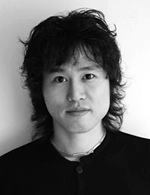 Professor Sang-Min received an award for scholar of the year from the KAISTian of the Year 2013
KAIST nominates a “Scholar of the Year” each year and presents the award to the recipient at a New Year’s opening ceremony. For the year 2013, Professor Sang-Min Bae of the Industrial Design Department at KAIST was named “KAIST Scholar of 2013” and received the award on January 2, 2014.
Professor Bae has been recognized for his design achievement in 2013: D’Light, a kinetic lighting that employs a transformable lampshade using flexible honeycomb structure, became one of the finalists in the living room and bedroom category of the International Design Excellence Award 2013 and was selected one of the best 100 for the 2013 Good Design Award. Users can easily change the shape and light intensity of the lamp by simply pivoting the lampshade with its small handle.
Professor Bae has also actively pursued his own philanthrophic projects through design: he has given the profits from the sales of his designs including D’Light directly toward a scholarship for needy children.
The Scholar of the Year award is presented to a faculty member or researcher at KAIST who has contributed to the advancement of science and technology such as publication of articles with influential research outcomes, invention of breakthrough technology, implementation of outstanding research projects, and improvement of public life. Professor Bae is the 13 th winner of the KAIST award.
The Korea Times, a leading English language newspaper in Korea, published an article on this award. For the article, please visit http://www.koreatimes.co.kr/www/news/people/2014/01/178_149117.html .
2014.01.09 View 10643
Professor Sang-Min received an award for scholar of the year from the KAISTian of the Year 2013
KAIST nominates a “Scholar of the Year” each year and presents the award to the recipient at a New Year’s opening ceremony. For the year 2013, Professor Sang-Min Bae of the Industrial Design Department at KAIST was named “KAIST Scholar of 2013” and received the award on January 2, 2014.
Professor Bae has been recognized for his design achievement in 2013: D’Light, a kinetic lighting that employs a transformable lampshade using flexible honeycomb structure, became one of the finalists in the living room and bedroom category of the International Design Excellence Award 2013 and was selected one of the best 100 for the 2013 Good Design Award. Users can easily change the shape and light intensity of the lamp by simply pivoting the lampshade with its small handle.
Professor Bae has also actively pursued his own philanthrophic projects through design: he has given the profits from the sales of his designs including D’Light directly toward a scholarship for needy children.
The Scholar of the Year award is presented to a faculty member or researcher at KAIST who has contributed to the advancement of science and technology such as publication of articles with influential research outcomes, invention of breakthrough technology, implementation of outstanding research projects, and improvement of public life. Professor Bae is the 13 th winner of the KAIST award.
The Korea Times, a leading English language newspaper in Korea, published an article on this award. For the article, please visit http://www.koreatimes.co.kr/www/news/people/2014/01/178_149117.html .
2014.01.09 View 10643 -
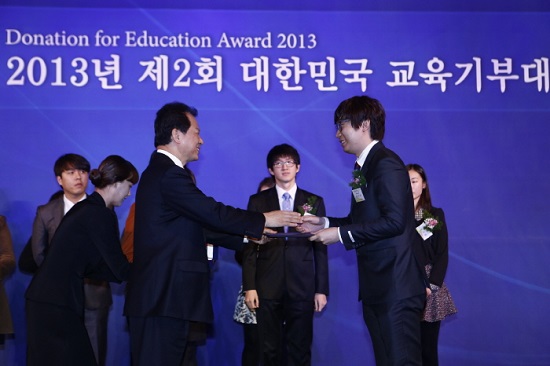 An Education Donation Club at KAIST Received the Education Minister's Award in 2013
Chalk, one of the student clubs at KAIST, shares knowledge by providing free online classes to teenage students in Korea via Internet.
Chalk, a KAIST student club which donates their educational knowledge, received an award from the Education Minister of the Republic of Korea at the 2nd Donation for Education Award held on December 16th, 2013 at the Plaza Hotel in Seoul.
The Donation for Eduation Award aims to find and reward corporations, organizations, and individuals, which have actively contributed to growing the dreams and talents of students, as well as revitalizing the culture of donation for education. It has been awarded by the Ministry of Education since 2012 to promote the awareness and participation of students for education.
Chalk provides free online video lectures on www.playchalk.com and runs a mentoring-based education program. The club has been recognized for offering online courses, math and science classes in particular, to teenage students who are from socially and economically less privileged backgrounds.
Chalk was founded by five KAIST students in 2011. Their ultimate goal is to create a society where students can fully enjoy the benefits of education, regardless of their economic conditions. About 60 undergraduate students currently participate in the club, with more than 5,000 students attending over 160 lectures without any cost.
2014.01.07 View 9769
An Education Donation Club at KAIST Received the Education Minister's Award in 2013
Chalk, one of the student clubs at KAIST, shares knowledge by providing free online classes to teenage students in Korea via Internet.
Chalk, a KAIST student club which donates their educational knowledge, received an award from the Education Minister of the Republic of Korea at the 2nd Donation for Education Award held on December 16th, 2013 at the Plaza Hotel in Seoul.
The Donation for Eduation Award aims to find and reward corporations, organizations, and individuals, which have actively contributed to growing the dreams and talents of students, as well as revitalizing the culture of donation for education. It has been awarded by the Ministry of Education since 2012 to promote the awareness and participation of students for education.
Chalk provides free online video lectures on www.playchalk.com and runs a mentoring-based education program. The club has been recognized for offering online courses, math and science classes in particular, to teenage students who are from socially and economically less privileged backgrounds.
Chalk was founded by five KAIST students in 2011. Their ultimate goal is to create a society where students can fully enjoy the benefits of education, regardless of their economic conditions. About 60 undergraduate students currently participate in the club, with more than 5,000 students attending over 160 lectures without any cost.
2014.01.07 View 9769 -
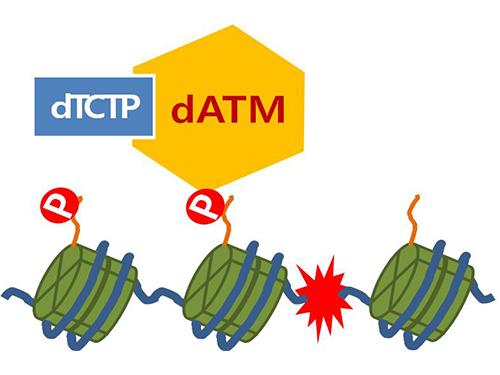 Mechanism in regulation of cancer-related key enzyme, ATM, for DNA damage and repair revealed
Professor Kwang-Wook Choi
A research team led by Professor Kwang-Wook Choi and Dr. Seong-Tae Hong from the Department of Biological Sciences at KAIST has successfully investigated the operational mechanism of the protein Ataxia Telangiectasia Mutated (ATM), an essential protein to the function of a crucial key enzyme that repairs the damaged DNA which stores biometric information. The results were published on December 19th Nature Communications online edition.
All organisms, including humans, constantly strive to protect the information within their DNA from damages posed by a number of factors, such as carbonized materials in our daily food intake, radioactive materials such as radon emitting from the cement of buildings or ultraviolet of the sunlight, which could be a trigger for cancer.
In order to keep the DNA information safe, the organisms are always carrying out complex and sophisticated DNA repair work, which involves the crucial DNA damage repair protein ATM. Consequently, a faulty ATM leads to higher risks of cancer.
Until now, academia predicted that the Translationally Controlled Tumor Protein (TCTP) will play an important role in regulating the function of ATM. However, since most of main research regarding TCTP has only been conducted in cultured cells, it was unable to identify exactly what mechanisms TCTP employs to control ATM.
The KAIST research team identified that TCTP can combine with ATM or increase the enzymatic activity of ATM. In addition, Drosophilia, one of the most widely used model organisms for molecular genetics, has been used to identify that TCTP and ATM play a very important role in repairing the DNA damaged by radiation. This information has allowed the researchers to establish TCTP’s essential function in maintaining the DNA information in cell cultures and even in higher organisms, and to provide specific and important clues to the regulation of ATM by TCTP.
Professor Kwang-Wook Choi said, “Our research is a good example that basic research using Drosophilia can make important contributions to understanding the process of diseases, such as cancer, and to developing adequate treatment.”
The research has been funded by the Ministry of Science, ICT and Future Planning, Republic of Korea, and the National Research Foundation of Korea.
Figure 1. When the amount of TCTP protein is reduced, cells of the Drosophila's eye are abnormally deformed by radiation. Scale bars = 200mm
Figure 2. When the amount of TCTP protein is reduced, the chromosomes of Drosophilia are easily broken by radiation. Scale bars = 10 mm.
Figure 3. When gene expressions of TCTP and ATM are reduced, large defects occur in the normal development of the eye. (Left: normal Drosophilia's eye, right: development-deficient eye)
Figure 4. ATM marks the position of the broken DNA, with TCTP helping to facilitate this reaction. DNA (blue line) within the cell nucleus is coiled around the histone protein (green cylinder). When DNA is broken, ATM protein attaches a phosphate group (P). Multiple DNA repair protein recognizes the phosphate as a signal that requires repair and gathers at the site.
2014.01.07 View 13276
Mechanism in regulation of cancer-related key enzyme, ATM, for DNA damage and repair revealed
Professor Kwang-Wook Choi
A research team led by Professor Kwang-Wook Choi and Dr. Seong-Tae Hong from the Department of Biological Sciences at KAIST has successfully investigated the operational mechanism of the protein Ataxia Telangiectasia Mutated (ATM), an essential protein to the function of a crucial key enzyme that repairs the damaged DNA which stores biometric information. The results were published on December 19th Nature Communications online edition.
All organisms, including humans, constantly strive to protect the information within their DNA from damages posed by a number of factors, such as carbonized materials in our daily food intake, radioactive materials such as radon emitting from the cement of buildings or ultraviolet of the sunlight, which could be a trigger for cancer.
In order to keep the DNA information safe, the organisms are always carrying out complex and sophisticated DNA repair work, which involves the crucial DNA damage repair protein ATM. Consequently, a faulty ATM leads to higher risks of cancer.
Until now, academia predicted that the Translationally Controlled Tumor Protein (TCTP) will play an important role in regulating the function of ATM. However, since most of main research regarding TCTP has only been conducted in cultured cells, it was unable to identify exactly what mechanisms TCTP employs to control ATM.
The KAIST research team identified that TCTP can combine with ATM or increase the enzymatic activity of ATM. In addition, Drosophilia, one of the most widely used model organisms for molecular genetics, has been used to identify that TCTP and ATM play a very important role in repairing the DNA damaged by radiation. This information has allowed the researchers to establish TCTP’s essential function in maintaining the DNA information in cell cultures and even in higher organisms, and to provide specific and important clues to the regulation of ATM by TCTP.
Professor Kwang-Wook Choi said, “Our research is a good example that basic research using Drosophilia can make important contributions to understanding the process of diseases, such as cancer, and to developing adequate treatment.”
The research has been funded by the Ministry of Science, ICT and Future Planning, Republic of Korea, and the National Research Foundation of Korea.
Figure 1. When the amount of TCTP protein is reduced, cells of the Drosophila's eye are abnormally deformed by radiation. Scale bars = 200mm
Figure 2. When the amount of TCTP protein is reduced, the chromosomes of Drosophilia are easily broken by radiation. Scale bars = 10 mm.
Figure 3. When gene expressions of TCTP and ATM are reduced, large defects occur in the normal development of the eye. (Left: normal Drosophilia's eye, right: development-deficient eye)
Figure 4. ATM marks the position of the broken DNA, with TCTP helping to facilitate this reaction. DNA (blue line) within the cell nucleus is coiled around the histone protein (green cylinder). When DNA is broken, ATM protein attaches a phosphate group (P). Multiple DNA repair protein recognizes the phosphate as a signal that requires repair and gathers at the site.
2014.01.07 View 13276 -
 Professor Yong-Hee Lee of Physics Received the Humboldt Research Award
In recognition of his past accomplishments in research and teaching, Professor Yong-Hee Lee of Physics at KAIST received the Humboldt Research Award in November 2013. The Humboldt Research Award is annually given by the Alexander von Humboldt Foundation to internationally renowned scientists and scholars in the fields of biology, chemistry, computer science, economics, linguistics, management, mathematics, medicine, philosophy, and physics. The winners of the award are offered with 60,000 Euros of research grant as well as an opportunity to undertake prolonged periods of research in collaboration with researchers in Germany.Professor Lee, who may be the first Korean physicist receiving the award, plans to conduct joint research with colleagues at the Technical University of Berlin and University of Würzburg.
2014.01.05 View 8748
Professor Yong-Hee Lee of Physics Received the Humboldt Research Award
In recognition of his past accomplishments in research and teaching, Professor Yong-Hee Lee of Physics at KAIST received the Humboldt Research Award in November 2013. The Humboldt Research Award is annually given by the Alexander von Humboldt Foundation to internationally renowned scientists and scholars in the fields of biology, chemistry, computer science, economics, linguistics, management, mathematics, medicine, philosophy, and physics. The winners of the award are offered with 60,000 Euros of research grant as well as an opportunity to undertake prolonged periods of research in collaboration with researchers in Germany.Professor Lee, who may be the first Korean physicist receiving the award, plans to conduct joint research with colleagues at the Technical University of Berlin and University of Würzburg.
2014.01.05 View 8748 -
 Professor Dong-Yol Yang received an award for scholar of the year 2013 from the Korean mechanical engineering community
Professor Dong-Yol Yang from the Department of Mechanical Engineering at KAIST was selected as “the scholar of the year 2013” at an annual event held by the Korean Federation of Mechanical Engineering Societies, the Korea Association of Machinery Industry, and other mechanical engineering research institutes in Korea. The event, the Day of the Machines, is the nation’s biggest gathering for engineers, scholars, and researchers in mechanical engineering, at which winners of the awards for the person of the year in academia, business, and engineering are announced.
Professor Yang was chosen for his lifetime achievement as a scholar in the field of three-dimensional shape precision processing by developing an innovative processing technology that contributes to the advancement of mechanical engineering and industry. He also introduced the three-dimensional fast processing to Korea from 1990 and developed world-class subminiature fast processing, the first of its kind in Korea.In 2013, Professor Yang identified geometric deformation elements in mechanical engineering for the first time in the world, an essential component for nano mobile system and received the best conference paper award at the 3M-Nano International Conference.
2014.01.05 View 9368
Professor Dong-Yol Yang received an award for scholar of the year 2013 from the Korean mechanical engineering community
Professor Dong-Yol Yang from the Department of Mechanical Engineering at KAIST was selected as “the scholar of the year 2013” at an annual event held by the Korean Federation of Mechanical Engineering Societies, the Korea Association of Machinery Industry, and other mechanical engineering research institutes in Korea. The event, the Day of the Machines, is the nation’s biggest gathering for engineers, scholars, and researchers in mechanical engineering, at which winners of the awards for the person of the year in academia, business, and engineering are announced.
Professor Yang was chosen for his lifetime achievement as a scholar in the field of three-dimensional shape precision processing by developing an innovative processing technology that contributes to the advancement of mechanical engineering and industry. He also introduced the three-dimensional fast processing to Korea from 1990 and developed world-class subminiature fast processing, the first of its kind in Korea.In 2013, Professor Yang identified geometric deformation elements in mechanical engineering for the first time in the world, an essential component for nano mobile system and received the best conference paper award at the 3M-Nano International Conference.
2014.01.05 View 9368 -
 Professor Dong-Soo Han received the Prime Minister's award for creative economy in 2013
The 2013 Korea Creative Economy Awards, presented to companies or individuals that contributed to the implementation of the Korean government’s economic growth initiative called “creative economy” with the development of new technology, was held on December 12th at the InterContinental Seoul Coex. Professor Dong-Soo Han from the Department of Computer Science at KAIST received the Prime Minister’s award.
Professor Han was recognized for his research accomplishments on the development of an indoor GPS system and an integrated indoor/outdoor navigation system, as well as for his publication of a book for beginners who are interested in patents. He has applied 50 patents and registered 30 patents in Korea and abroad for the indoor positioning technology and smartphone application services.
His research work was also introduced to the public at the exhibition held after the award ceremony during December 12th-15th at the Coex convention center in Seoul.
2014.01.05 View 8170
Professor Dong-Soo Han received the Prime Minister's award for creative economy in 2013
The 2013 Korea Creative Economy Awards, presented to companies or individuals that contributed to the implementation of the Korean government’s economic growth initiative called “creative economy” with the development of new technology, was held on December 12th at the InterContinental Seoul Coex. Professor Dong-Soo Han from the Department of Computer Science at KAIST received the Prime Minister’s award.
Professor Han was recognized for his research accomplishments on the development of an indoor GPS system and an integrated indoor/outdoor navigation system, as well as for his publication of a book for beginners who are interested in patents. He has applied 50 patents and registered 30 patents in Korea and abroad for the indoor positioning technology and smartphone application services.
His research work was also introduced to the public at the exhibition held after the award ceremony during December 12th-15th at the Coex convention center in Seoul.
2014.01.05 View 8170 -
 Professor Jung-Ro Yoon Appointed President of Korean Sociological Association
The Korean Sociological Association (KSA) announced that Professor Jung-Ro Yoon from the Department of Humanities and Social Science at KAIST has been appointed as the president of KSA.
KSA has been contributing in the development of sociology and academic exchange among its members as the largest academic association in the field of social science in Korea since 1957.
Professor Yoon said, “KSA is trying to contribute to finding new solutions for economic crises, inequality, environmental pollution, and other uncertainties that we have been facing. We will attempt to provide vision and hope for the future of the society with cooperation from both students and researchers under the motto ‘Sociology for Research, Play and Communication.’”
Dr. Yoon has been in the Department of Humanities and Social Science at KAIST since 1991 after earning her MA & Ph.D. degree from Harvard University. She introduced Science, Technology and Society (STS) into Korea and served as the leader of the Ethical, Legal and Social Implications (ELSI) Project for the Utilization of Human Genome Information.
2014.01.02 View 8399
Professor Jung-Ro Yoon Appointed President of Korean Sociological Association
The Korean Sociological Association (KSA) announced that Professor Jung-Ro Yoon from the Department of Humanities and Social Science at KAIST has been appointed as the president of KSA.
KSA has been contributing in the development of sociology and academic exchange among its members as the largest academic association in the field of social science in Korea since 1957.
Professor Yoon said, “KSA is trying to contribute to finding new solutions for economic crises, inequality, environmental pollution, and other uncertainties that we have been facing. We will attempt to provide vision and hope for the future of the society with cooperation from both students and researchers under the motto ‘Sociology for Research, Play and Communication.’”
Dr. Yoon has been in the Department of Humanities and Social Science at KAIST since 1991 after earning her MA & Ph.D. degree from Harvard University. She introduced Science, Technology and Society (STS) into Korea and served as the leader of the Ethical, Legal and Social Implications (ELSI) Project for the Utilization of Human Genome Information.
2014.01.02 View 8399 -
 KAIST Student Awarded Prize from Energy Saving Contest
Jun-Min Kwon, an undergraduate student in the Department of Chemistry at KAIST, was awarded a prize from the Ministry of Trade, Industry and Energy, Republic of Korea, at the 35th Energy Saving Contest which was held on November 20.
The student club he has been leading was also selected as one of the best groups by the Save Energy Save Earth (SESE), a volunteer organization supported by the Korea Energy Management Corporation and the Ministry of Knowledge Economy, Republic of Korea.
Kwon began promoting energy conservation through a blog and participated in related meetings and workshops as a high school student to improve the understanding on the importance of energy saving and recycling.He also received awards from the Second National Assembly Forum on Climate Change, the Korean National Science Fair, as well as the Samsung Human Tech Paper Award.
2013.12.24 View 12486
KAIST Student Awarded Prize from Energy Saving Contest
Jun-Min Kwon, an undergraduate student in the Department of Chemistry at KAIST, was awarded a prize from the Ministry of Trade, Industry and Energy, Republic of Korea, at the 35th Energy Saving Contest which was held on November 20.
The student club he has been leading was also selected as one of the best groups by the Save Energy Save Earth (SESE), a volunteer organization supported by the Korea Energy Management Corporation and the Ministry of Knowledge Economy, Republic of Korea.
Kwon began promoting energy conservation through a blog and participated in related meetings and workshops as a high school student to improve the understanding on the importance of energy saving and recycling.He also received awards from the Second National Assembly Forum on Climate Change, the Korean National Science Fair, as well as the Samsung Human Tech Paper Award.
2013.12.24 View 12486 -
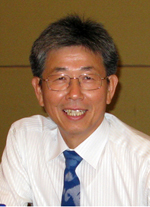 Professor Suk-Joo Na Invited to Finland as Distinguished Professor
Professor Suk-Joo Na, from the Department of Mechanical Engineering at KAIST, has been invited as a distinguished professor for an international research project in Finland.
As a leading scientist in the field of arc welding and numerical analysis of the laser welding process, Na will assemble a research group for the interpretation of the welding processes for three years at the VVT Technical Research Centre of Finland beginning in January of 2014.
The project was established to improve the research level and national competitiveness of Finland by inviting leading international scientists to the National Technology Agency of Finland and Academy of Finland since 2006 and over one hundred projects have been carried out thus far. A total of 17 billion won will be invested for the eleven new projects selected this year. Professor Na said, “The fusion welding field contains important technology for improving the competitiveness of mechanical products of Finland. Improvements in productivity, the life cycles of products, and energy saving through interpretation technology for the numerical analysis of the welding process will make a huge impact on the national economy of Finland.”
2013.12.24 View 9667
Professor Suk-Joo Na Invited to Finland as Distinguished Professor
Professor Suk-Joo Na, from the Department of Mechanical Engineering at KAIST, has been invited as a distinguished professor for an international research project in Finland.
As a leading scientist in the field of arc welding and numerical analysis of the laser welding process, Na will assemble a research group for the interpretation of the welding processes for three years at the VVT Technical Research Centre of Finland beginning in January of 2014.
The project was established to improve the research level and national competitiveness of Finland by inviting leading international scientists to the National Technology Agency of Finland and Academy of Finland since 2006 and over one hundred projects have been carried out thus far. A total of 17 billion won will be invested for the eleven new projects selected this year. Professor Na said, “The fusion welding field contains important technology for improving the competitiveness of mechanical products of Finland. Improvements in productivity, the life cycles of products, and energy saving through interpretation technology for the numerical analysis of the welding process will make a huge impact on the national economy of Finland.”
2013.12.24 View 9667